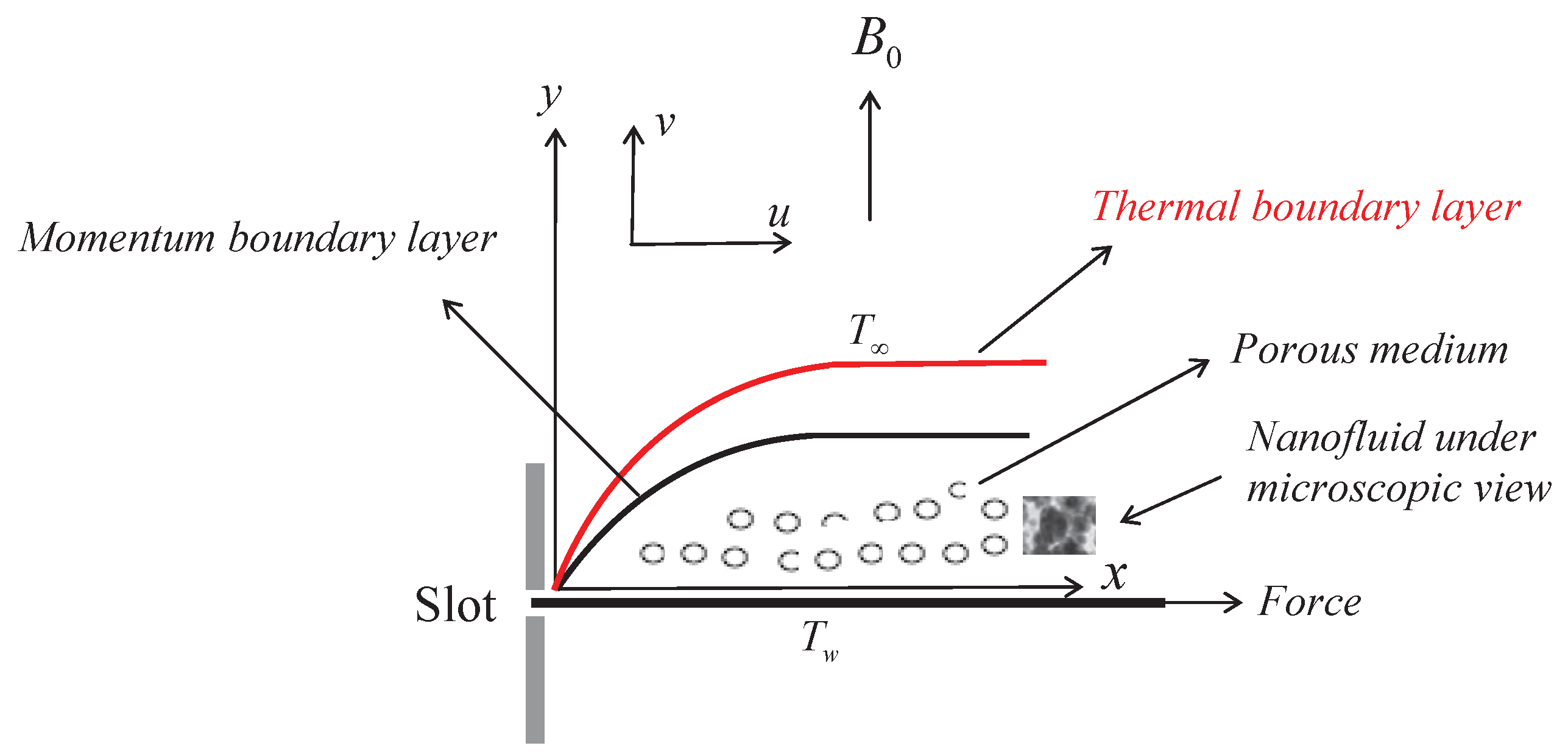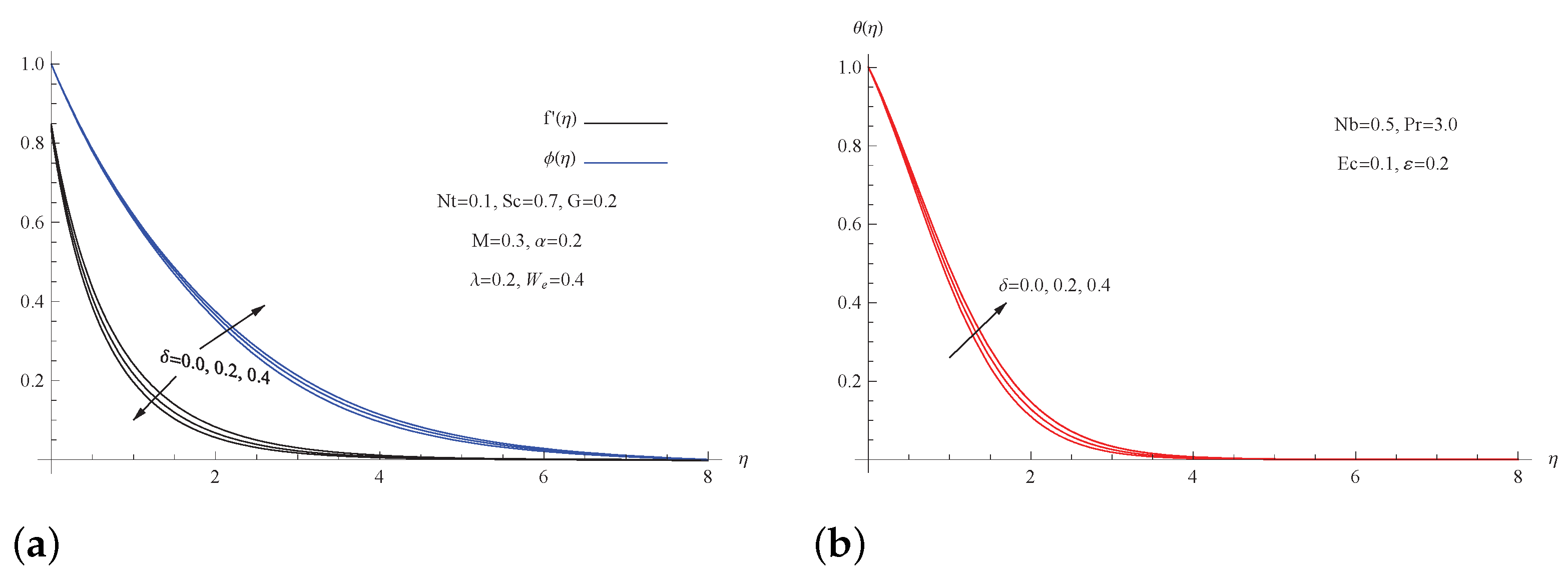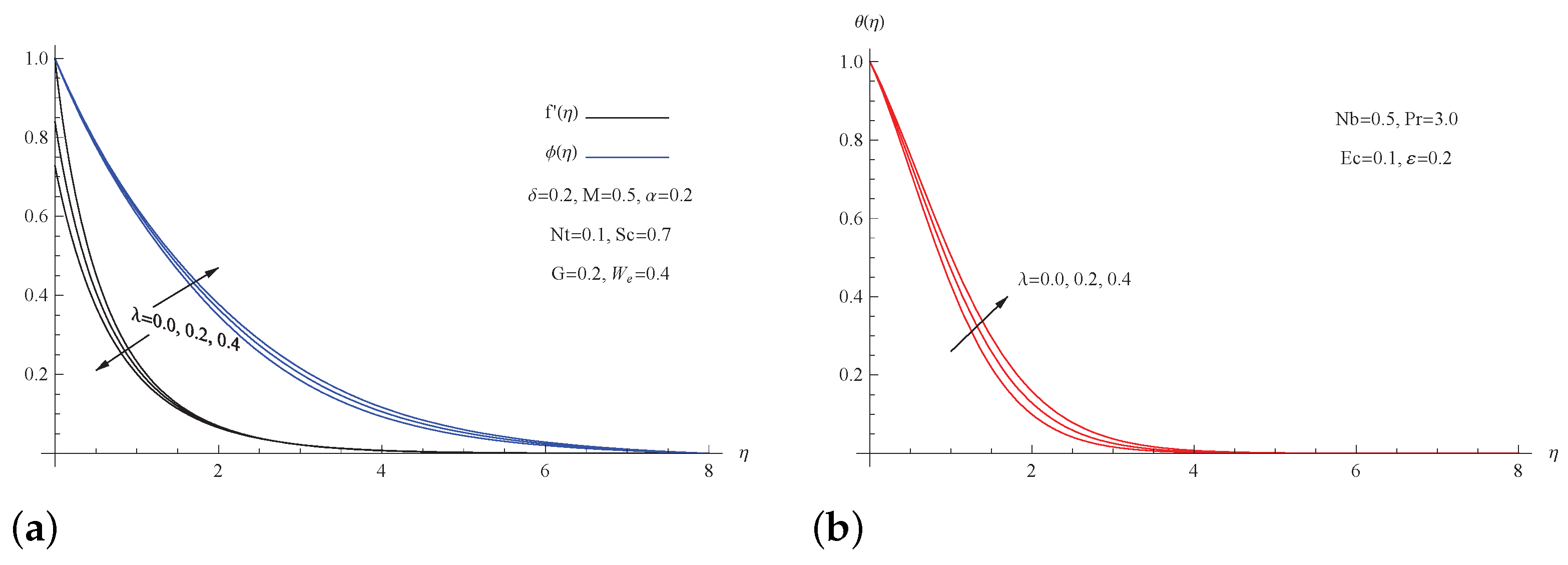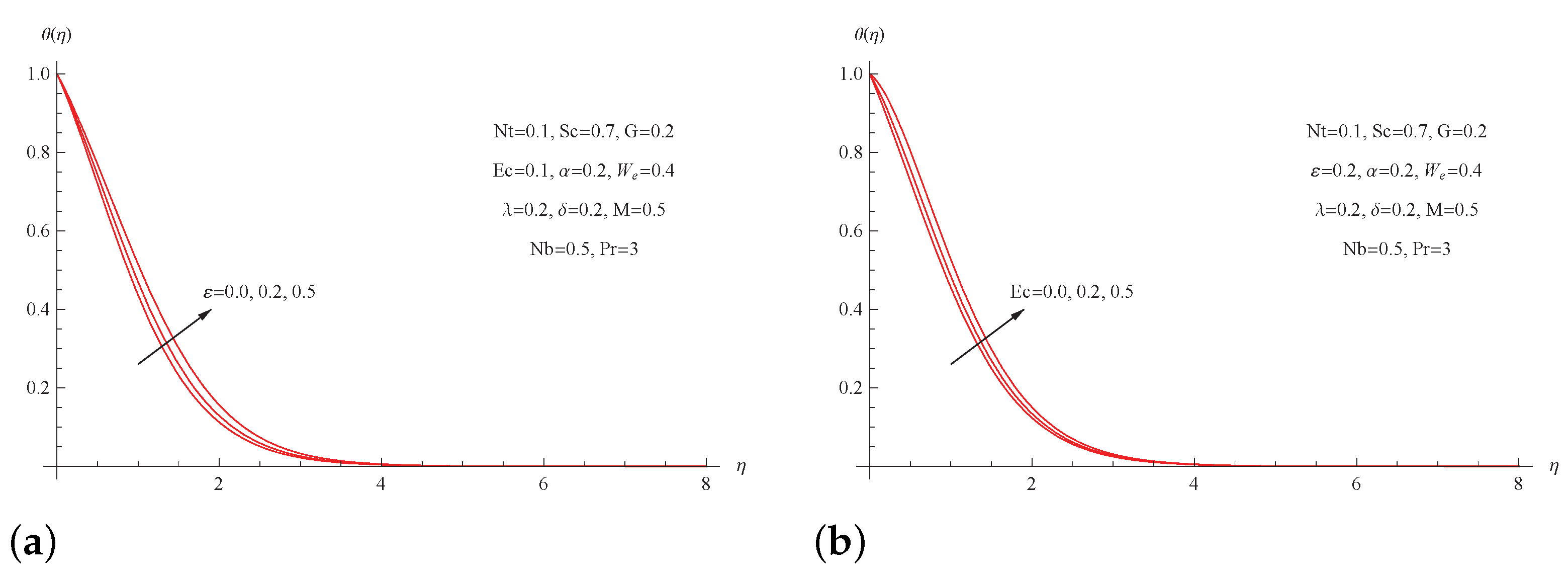MHD Dissipative Williamson Nanofluid Flow with Chemical Reaction Due to a Slippery Elastic Sheet Which Was Contained within a Porous Medium
Abstract
1. Introduction
2. Description of the Problem
3. Results and Discussion
4. Conclusions
- 1.
- The viscosity parameter, the porous parameter, and the magnetic parameter all show a decrease in velocity.
- 2.
- Temperature rises as the Eckert number, magnetic parameter, porosity parameter, and slip velocity parameter increase.
- 3.
- When the viscosity parameter, magnetic number, and porous parameter are increased, the skin-friction coefficient rises, whereas the chemical reaction parameter, Brownian motion parameter, and Eckert number grow in the opposite direction.
- 4.
- The skin-friction coefficient and the local Nusselt number decline for the mounting values of thermal conductivity parameter and the Eckert number, whereas an enhancement in the local Sherwood number is observed.
- 5.
- When the Brownian motion parameter and the chemical reaction parameter are both increased, the local Sherwood number increases; however, the increasing values of the slip velocity parameter and viscosity parameter have the opposite effect.
Author Contributions
Funding
Data Availability Statement
Acknowledgments
Conflicts of Interest
References
- Choi, S.U.S.; Zhang, Z.G.; Yu, W.; Lockwood, F.E.; Grulke, E.A. Anomalous thermal conductivity enhancement in nanotube suspensions. Appl. Phys. Lett. 2001, 79, 2252–2254. [Google Scholar] [CrossRef]
- Ghoneim, N.I.; Megahed, A.M. Hydromagnetic nanofluid film flow over a stretching sheet with prescribed heat flux and viscous dissipation. Fluid Dyn. Mater. Process. 2022, 18, 1373–1388. [Google Scholar] [CrossRef]
- Nadeem, S.; Haq, R.U.; Khan, Z.H. Numerical study of MHD boundary layer flow of a Maxwell fluid past a stretching sheet in the presence of nanoparticles. J. Taiwan Inst. Chem. Eng. 2014, 45, 121–126. [Google Scholar] [CrossRef]
- Rashad, A.M.; Chamkha, A.J.; Modather, M. Mixed convection boundary-layer flow past a horizontal circular cylinder embedded in a porous medium filled with a nanofluid under convective boundary conditio. Comput. Fluids 2013, 86, 380–388. [Google Scholar] [CrossRef]
- Armaghani, T.; Chamkha, A.J.; Maghrebi, J.; Nazari, M. Numerical analysis of a nanofluid forced convection in a porous channel: A new heat flux model in LTNE condition. J. Porous Media 2014, 17, 637–646. [Google Scholar] [CrossRef]
- Umavathi, J.C.; Chamkha, A.J.; Mohite, M.B. Convective transport in nanofluid saturated porous layer with crossdiffusion and variation of viscosity and conductivity. Special Topics Rev. Porous Media 2015, 6, 11–27. [Google Scholar] [CrossRef]
- Gireesha, B.J.; Mahanthesh, B.; Shivakumara, I.S.; Eshwarappa, K.M. Melting heat transfer in boundary layer stagnation-point flow of nanofluid toward a stretching sheet with induced magnetic field. Eng. Sci. Tech. Int. J. 2016, 19, 313–321. [Google Scholar] [CrossRef]
- Gul, H.; Ramzan, M.; Chung, J.D.; Chu, Y.M.; Kadry, S. Multiple slips impact in the MHD hybrid nanofluid flow with Cattaneo-Christov heat flux and autocatalytic chemical reaction. Sci. Rep. 2021, 11, 14625. [Google Scholar] [CrossRef]
- Ullah, I. Heat transfer enhancement in Marangoni convection and nonlinear radiative flow of gasoline oil conveying Boehmite alumina and aluminum alloy nanoparticles. Int. Commun. Heat Mass Transf. 2022, 132, 105920. [Google Scholar] [CrossRef]
- Muhammad Ramzan, M.; Riasat, S.; Chung, J.D.; Chu, Y.M.; Sheikholeslami, M.; Kadry, S.; Howari, F. Upshot of heterogeneous catalysis in a nanofluid flow over a rotating disk with slip effects and Entropy optimization analysis. Sci. Rep. 2021, 11, 120. [Google Scholar] [CrossRef]
- Ullah, I.; Hayat, T.; Alsaedi, A. Optimization of entropy production in flow of hybrid nanomaterials through Darcy-Forchheimer porous space. J. Therm. Anal. Calorim. 2022, 147, 5855–5864. [Google Scholar] [CrossRef]
- Ramzan, M.; Shaheen, N.; Chung, J.D.; Kadry, S.; Chu, Y.M.; Howari, F. Impact of Newtonian heating and Fourier and Fick’s laws on a magnetohydrodynamic dusty Casson nanofluid flow with variable heat source/sink over a stretching cylinder. Sci. Rep. 2021, 11, 2357. [Google Scholar] [CrossRef] [PubMed]
- Ullah, I.; Alghamdi, M.; Xia, W.-F.; Shah, S.I.; Khan, H. Activation energy effect on the magnetized-nanofluid flow in a rotating system considering the exponential heat source. Int. Commun. Heat Mass Transf. 2021, 128, 105578. [Google Scholar] [CrossRef]
- Ullah, I.; Ullah, R.; Alqarni, M.S.; Xia, W.; Muhammad, T. Combined heat source and zero mass flux features on magnetized nanofluid flow by radial disk with the applications of Coriolis force and activation energy. Int. Commun. Heat Mass Transf. 2021, 126, 105416. [Google Scholar] [CrossRef]
- Shaheen, N.; Ramzan, M.; Alshehri, A.; Shah, Z.; Kumam, P. Soret-Dufour impact on a three-dimensional Casson nanofluid flow with dust particles and variable characteristics in a permeable media. Sci. Rep. 2021, 11, 14513. [Google Scholar] [CrossRef]
- Ramzan, M.; Shahmir, N.; Ghazwani, H.A.S. Hybrid nanofluid flow comprising spherical shaped particles with Hall current and irreversibility analysis: An application of solar radiation. Waves Random Complex Media 2022. [Google Scholar] [CrossRef]
- Qasim, M.; Khan, Z.H.; Lopez, R.J.; Khan, W.A. Heat and mass transfer in nanofluid over an unsteady stretching sheet using Buongiorno’s model. Eur. Phys. J. Plus 2016, 131, 1–16. [Google Scholar] [CrossRef]
- Hussain, Z.; Hayat, T.; Alsaedi, A.; Ullah, I. On MHD convective flow of Williamson fluid with homogeneous-heterogeneous reactions: A comparative study of sheet and cylinder. Int. Commun. Heat Mass Transf. 2021, 120, 105060. [Google Scholar] [CrossRef]
- Patel, H.R.; Mittal, A.S.; Darji, R.R. MHD flow of micropolar nanofluid over a stretching/shrinking sheet considering radiation. Int. Commun. Heat Mass Transf. 2019, 108, 104322. [Google Scholar] [CrossRef]
- Yousef, N.S.; Megahed, A.M.; Ghoneim, N.I.; Elsafi, M.; Fares, E. Chemical reaction impact on MHD dissipative Casson-Williamson nanofluid flow over a slippery stretching sheet through porous medium. Alex. Eng. J. 2022, 61, 10161–10170. [Google Scholar] [CrossRef]
- Aminossadati, S.M.; Raisi, A.; Ghasemi, B. Effects of magnetic field on nanofluid forced convection in a partially heated microchannel. Int. J. Non-Linear Mech. 2011, 46, 1373–1382. [Google Scholar] [CrossRef]
- Ghasemi, B.; Aminossadati, S.M.; Raisi, A. Magnetic field effect on natural convection in a nanofluid-filled square enclosure. Int. J. Therm. Sci. 2011, 50, 1748–1756. [Google Scholar] [CrossRef]
- Humane, P.P.; Patil, V.S.; Patil, A.B. Chemical reaction and thermal radiation effects on magnetohydrodynamics flow of Casson-Williamson nanofluid over a porous stretching surface. J. Process. Mech. Eng. 2021, 235, 2008–2018. [Google Scholar] [CrossRef]
- Ullah, I.; Waqas, M.; Hayat, T.; Alsaedi, A.; Khan, M. Thermally radiated squeezed flow of magneto-nanofluid between two parallel disks with chemical reaction. J. Therm. Anal. Calorim. 2019, 135, 1021–1030. [Google Scholar] [CrossRef]
- Raju, C.S.K.; Babu, M.J.; Sandeep, N. Chemically reacting radiative MHD Jeffrey nanofluid flow over a cone in porous medium. Int. J. Eng. Res. Afr. 2016, 19, 75–90. [Google Scholar] [CrossRef]
- Sharma, K.; Gupta, S. Viscous dissipation and thermal radiation effects in MHD flow of Jeffrey nanofluid through impermeable surface with heat generation/absorption. Nonlinear Eng. 2017, 6, 153–166. [Google Scholar] [CrossRef]
- Alotaibi, H.; Althubiti, S.; Eid, M.R.; Mahny, K.L. Numerical treatment of MHD flow of Casson nanofluid via convectively heated nonlinear extending surface with viscous dissipation and suction/injection effects. Comput. Mater. Continua. 2021, 66, 229–245. [Google Scholar] [CrossRef]
- Mangathai, P.; Reddy, B.R.; Sidhartha, C. Unsteady MHD Williamson and Casson nano fluid flow in the presence of radiation and viscous dissipation. Turk. J. Comput. Math. Educ. 2021, 12, 1036–1051. [Google Scholar]
- Alali, E.; Megahed, M.A. MHD dissipative Casson nanofluid liquid film flow due to an unsteady stretching sheet with radiation influence and slip velocity phenomenon. Nanotechnol. Rev. 2022, 11, 463–472. [Google Scholar] [CrossRef]
- Sobamowo, G.M.; Jayesimi, L.O. Squeezing flow analysis of nanofluid under the effects of magnetic field and slip boundary conditions using chebychev cpectral collocation method. Fluid Mech. 2017, 3, 54–60. [Google Scholar] [CrossRef]
- Noor, N.A.M.; Shafie, S.; Admon, M.A. Slip effects on MHD squeezing flow of Jeffrey nanofluid in horizontal channel with chemical reaction. Mathematics 2021, 9, 1215. [Google Scholar] [CrossRef]
- Megahed, A.M. Improvement of heat transfer mechanism through a Maxwell fluid flow over a stretching sheet embedded in a porous medium and convectively heated. Math. Comput. Simul. 2021, 187, 97–109. [Google Scholar] [CrossRef]
- Nadeem, S.; Hussain, S.T. Flow and heat transfer analysis of Williamson nanofluid. Appl. Nanosci. 2014, 4, 1005–1012. [Google Scholar] [CrossRef]
- Rafique, K.; Alotaibi, H. Numerical simulation of Williamson nanofluid flow over an inclined surface: Keller box analysis. Appl. Sci. 2021, 11, 11523. [Google Scholar] [CrossRef]
- Megahed, A.M. Steady flow of MHD Williamson fluid due to a continuously moving surface with viscous dissipation and slip velocity. Int. J. Mod. Phys. C 2020, 31, 1–12. [Google Scholar] [CrossRef]
- Megahed, A.M. Flow and heat transfer of powell-eyring fluid due to an exponential stretching sheet with heat flux and variable thermal conductivity. Z. Naturforsch. 2015, 70, 163–169. [Google Scholar] [CrossRef]
- Khan, W.A.; Pop, I. Boundary-layer flow of a nanofluid past a stretching sheet. Int. J. Heat Mass Transf. 2010, 53, 2477–2483. [Google Scholar] [CrossRef]







| Khan and Pop [37] | Present Work | ||
|---|---|---|---|
| 0.1 | 0.1 | 0.9524 | 0.95239854 |
| 0.2 | 0.2 | 0.3654 | 0.36540037 |
| 0.3 | 0.3 | 0.1355 | 0.13548752 |
| 0.4 | 0.4 | 0.0495 | 0.04949979 |
| 0.5 | 0.5 | 0.0179 | 0.01787205 |
| M | G | |||||||||
|---|---|---|---|---|---|---|---|---|---|---|
| 0.1 | 0.2 | 0.2 | 0.2 | 0.2 | 0.1 | 0.5 | 0.2 | 0.924495 | 0.442366 | 0.503462 |
| 0.3 | 0.2 | 0.2 | 0.2 | 0.2 | 0.1 | 0.5 | 0.2 | 0.980413 | 0.416318 | 0.495631 |
| 0.5 | 0.2 | 0.2 | 0.2 | 0.2 | 0.1 | 0.5 | 0.2 | 1.030441 | 0.392609 | 0.489825 |
| 0.3 | 0.0 | 0.2 | 0.2 | 0.2 | 0.1 | 0.5 | 0.2 | 0.932834 | 0.439496 | 0.502721 |
| 0.3 | 0.2 | 0.2 | 0.2 | 0.2 | 0.1 | 0.5 | 0.2 | 0.980413 | 0.416318 | 0.495631 |
| 0.3 | 0.4 | 0.2 | 0.2 | 0.2 | 0.1 | 0.5 | 0.2 | 1.023210 | 0.395206 | 0.490356 |
| 0.3 | 0.2 | 0.0 | 0.2 | 0.2 | 0.1 | 0.5 | 0.2 | 0.874810 | 0.428961 | 0.501554 |
| 0.3 | 0.2 | 0.2 | 0.2 | 0.2 | 0.1 | 0.5 | 0.2 | 0.980413 | 0.416318 | 0.495631 |
| 0.3 | 0.2 | 0.5 | 0.2 | 0.2 | 0.1 | 0.5 | 0.2 | 1.147720 | 0.394267 | 0.486333 |
| 0.3 | 0.2 | 0.2 | 0.0 | 0.2 | 0.1 | 0.5 | 0.2 | 1.188541 | 0.434861 | 0.514142 |
| 0.3 | 0.2 | 0.2 | 0.2 | 0.2 | 0.1 | 0.5 | 0.2 | 0.980413 | 0.416318 | 0.495631 |
| 0.3 | 0.2 | 0.2 | 0.4 | 0.2 | 0.1 | 0.5 | 0.2 | 0.830424 | 0.394087 | 0.482866 |
| 0.3 | 0.2 | 0.2 | 0.2 | 0.0 | 0.1 | 0.5 | 0.2 | 0.981487 | 0.450101 | 0.490738 |
| 0.3 | 0.2 | 0.2 | 0.2 | 0.2 | 0.1 | 0.5 | 0.2 | 0.980413 | 0.416318 | 0.495631 |
| 0.3 | 0.2 | 0.2 | 0.2 | 0.5 | 0.1 | 0.5 | 0.2 | 0.979121 | 0.377751 | 0.501609 |
| 0.3 | 0.2 | 0.2 | 0.2 | 0.2 | 0.0 | 0.5 | 0.2 | 0.981267 | 0.482538 | 0.483647 |
| 0.3 | 0.2 | 0.2 | 0.2 | 0.2 | 0.2 | 0.5 | 0.2 | 0.979578 | 0.350767 | 0.508082 |
| 0.3 | 0.2 | 0.2 | 0.2 | 0.2 | 0.5 | 0.5 | 0.2 | 0.977066 | 0.153552 | 0.544668 |
| 0.3 | 0.2 | 0.2 | 0.2 | 0.2 | 0.1 | 0.3 | 0.2 | 0.982558 | 0.524028 | 0.441149 |
| 0.3 | 0.2 | 0.2 | 0.2 | 0.2 | 0.1 | 0.5 | 0.2 | 0.980413 | 0.416318 | 0.495631 |
| 0.3 | 0.2 | 0.2 | 0.2 | 0.2 | 0.1 | 1.0 | 0.2 | 0.975782 | 0.212324 | 0.530527 |
| 0.3 | 0.2 | 0.2 | 0.2 | 0.2 | 0.1 | 0.5 | 0.0 | 0.981627 | 0.487031 | 0.278046 |
| 0.3 | 0.2 | 0.2 | 0.2 | 0.2 | 0.1 | 0.5 | 0.2 | 0.980413 | 0.416318 | 0.495631 |
| 0.3 | 0.2 | 0.2 | 0.2 | 0.2 | 0.1 | 0.5 | 0.5 | 0.979654 | 0.368335 | 0.703169 |
Publisher’s Note: MDPI stays neutral with regard to jurisdictional claims in published maps and institutional affiliations. |
© 2022 by the authors. Licensee MDPI, Basel, Switzerland. This article is an open access article distributed under the terms and conditions of the Creative Commons Attribution (CC BY) license (https://creativecommons.org/licenses/by/4.0/).
Share and Cite
Alrihieli, H.; Areshi, M.; Alali, E.; Megahed, A.M. MHD Dissipative Williamson Nanofluid Flow with Chemical Reaction Due to a Slippery Elastic Sheet Which Was Contained within a Porous Medium. Micromachines 2022, 13, 1879. https://doi.org/10.3390/mi13111879
Alrihieli H, Areshi M, Alali E, Megahed AM. MHD Dissipative Williamson Nanofluid Flow with Chemical Reaction Due to a Slippery Elastic Sheet Which Was Contained within a Porous Medium. Micromachines. 2022; 13(11):1879. https://doi.org/10.3390/mi13111879
Chicago/Turabian StyleAlrihieli, Haifaa, Mounirah Areshi, Elham Alali, and Ahmed M. Megahed. 2022. "MHD Dissipative Williamson Nanofluid Flow with Chemical Reaction Due to a Slippery Elastic Sheet Which Was Contained within a Porous Medium" Micromachines 13, no. 11: 1879. https://doi.org/10.3390/mi13111879
APA StyleAlrihieli, H., Areshi, M., Alali, E., & Megahed, A. M. (2022). MHD Dissipative Williamson Nanofluid Flow with Chemical Reaction Due to a Slippery Elastic Sheet Which Was Contained within a Porous Medium. Micromachines, 13(11), 1879. https://doi.org/10.3390/mi13111879





